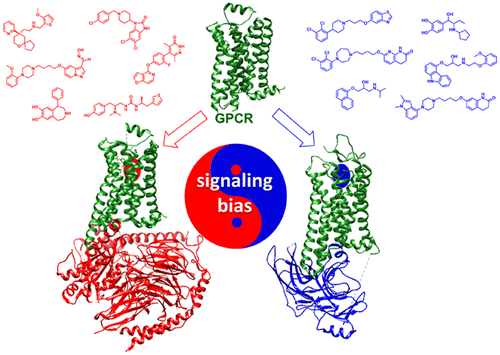当前位置:
X-MOL 学术
›
J. Med. Chem.
›
论文详情
Our official English website, www.x-mol.net, welcomes your
feedback! (Note: you will need to create a separate account there.)
Biased Ligands of G Protein-Coupled Receptors (GPCRs): Structure–Functional Selectivity Relationships (SFSRs) and Therapeutic Potential
Journal of Medicinal Chemistry ( IF 6.8 ) Pub Date : 2018-06-25 00:00:00 , DOI: 10.1021/acs.jmedchem.8b00435 Liang Tan 1 , Wenzhong Yan 1 , John D. McCorvy 2 , Jianjun Cheng 1
Journal of Medicinal Chemistry ( IF 6.8 ) Pub Date : 2018-06-25 00:00:00 , DOI: 10.1021/acs.jmedchem.8b00435 Liang Tan 1 , Wenzhong Yan 1 , John D. McCorvy 2 , Jianjun Cheng 1
Affiliation

|
G protein-coupled receptors (GPCRs) signal through both G-protein-dependent and G-protein-independent pathways, and β-arrestin recruitment is the most recognized one of the latter. Biased ligands selective for either pathway are expected to regulate biological functions of GPCRs in a more precise way, therefore providing new drug molecules with superior efficacy and/or reduced side effects. During the past decade, biased ligands have been discovered and developed for many GPCRs, such as the μ opioid receptor, the angiotensin II receptor type 1, the dopamine D2 receptor, and many others. In this Perspective, recent advances in this field are reviewed by discussing the structure–functional selectivity relationships (SFSRs) of GPCR biased ligands and the therapeutic potential of these molecules. Further understanding of the biological functions associated with each signaling pathway and structural basis for biased signaling will facilitate future drug design in this field.
中文翻译:

G蛋白偶联受体(GPCR)的配体:结构-功能选择性关系(SFSRs)和治疗潜力
G蛋白偶联受体(GPCR)通过G蛋白依赖性和G蛋白非依赖性途径发出信号,β-arrestin募集是后者中最公认的途径之一。对任一途径都具有选择性的偏向配体有望以更精确的方式调节GPCR的生物学功能,因此为新药分子提供了卓越的功效和/或减少的副作用。在过去的十年中,已经为许多GPCR发现并开发了偏配体,例如μ阿片受体,1型血管紧张素II受体,多巴胺D 2受体等。在本《观点》中,通过讨论GPCR偏向配体的结构-功能选择性关系(SFSR)以及这些分子的治疗潜力,回顾了该领域的最新进展。对与每个信号通路相关的生物学功能和偏向信号的结构基础的进一步理解将有助于该领域未来的药物设计。
更新日期:2018-06-25
中文翻译:

G蛋白偶联受体(GPCR)的配体:结构-功能选择性关系(SFSRs)和治疗潜力
G蛋白偶联受体(GPCR)通过G蛋白依赖性和G蛋白非依赖性途径发出信号,β-arrestin募集是后者中最公认的途径之一。对任一途径都具有选择性的偏向配体有望以更精确的方式调节GPCR的生物学功能,因此为新药分子提供了卓越的功效和/或减少的副作用。在过去的十年中,已经为许多GPCR发现并开发了偏配体,例如μ阿片受体,1型血管紧张素II受体,多巴胺D 2受体等。在本《观点》中,通过讨论GPCR偏向配体的结构-功能选择性关系(SFSR)以及这些分子的治疗潜力,回顾了该领域的最新进展。对与每个信号通路相关的生物学功能和偏向信号的结构基础的进一步理解将有助于该领域未来的药物设计。











































 京公网安备 11010802027423号
京公网安备 11010802027423号